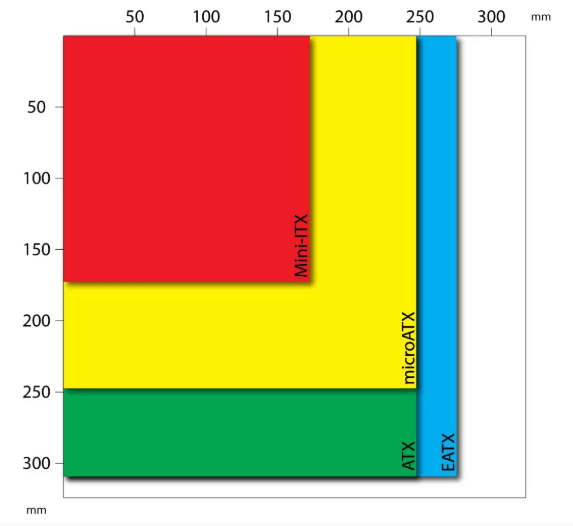What are the Different Motherboard Form Factors?
Microsoft MTA O/S | CompTIA A+ Exam objectives 1.2: sizes.
Introduction to Motherboards
A motherboard (MB), also known as a Mainboard, system board or logic board, is the central or primary circuit board in a Personal Computer (PC). It is an extremely complex electronic system that every device in a computer system connects to in order to send and receive data. A typical motherboard is made up of a main microprocessor, called the CPU, two or more DIMM slots to hold memory modules, support chips called the Chipset, controller ports for connecting storage drives, expansion slots for adding connections, and integrated input and output ports for connecting external devices.
Also known as a mainboard, system board, mobo or MB, here’s how a motherboard looks like:

Motherboard Form Factors
Motherboard form factors refer to the layout, features, and size of a motherboard. While there are dozens of form factors for desktop computers, most of them are either obsolete or developed for specialized purposes.
As a result, almost all consumer motherboards sold today belong to one of these form factors: ATX, Micro-ATX, Mini-ITX and EATX
What Does Each One Mean?
To start, let’s begin with the “standard”-sized motherboard which is the ATX. ATX stands for “Advanced Technology eXtended” and was developed as far back as 1995. If you own, or have owned, a regular-sized PC, there’s a good chance it has an ATX motherboard. This makes ATX the “regular” choice when purchasing a PC or motherboard.
From ATX, motherboards get either bigger or smaller in size. Going upward, you have the EATX motherboard (Extended ATX) which adds more to the ATX board and is slightly larger as a result. Going the other way, you have the Micro ATX which is smaller than the ATX. After that is the Mini ITX (“Information Technology eXtended”) which is even smaller than the Micro ATX.
ATX
The most popular standard for PC motherboards is ATX, which stands for Advanced Technology Extended. ATX motherboards are considered to be full-size with up to seven PCI/PCI Express (PCIe) expansion slots. Expansion slots are needed for things like graphics cards, sound cards, NVMe PCIe Solid State Drives (SSDs), and various peripherals. They also provide up to eight slots for RAM.
MINI-ITX
If you need a computer that is really small then you should look to Mini-ITX. These boards are primarily used in small form factor (SFF) computer systems where the entire computer must fit in a cabinet or on a bookshelf or otherwise be very portable. Typical uses include home theater PCs (HTPCs) where low power consumption means less noise from cooling fans and LAN gaming where you need something that is easy to carry around. Many new CPUs include integrated graphics eliminating the need for a dedicated graphics card if you aren’t after high resolution and/or high frame rates. This is good, because the Mini-ITX standard allows for just one PCI expansion port. To take full advantage of the smaller form factor you may need to find something other than a standard ATX power supply as they are generally too large for small Mini-ITX cases.
EATX
On the other hand, if space is not your concern, but performance and reliability are then eATX is for you. The e stands for extended making this an Extended Advanced Technology Extended motherboard. Boy that’s a mouthful. Generally these are used for enterprise-class high-performance workstations and servers. While it’s the same height as an ATX motherboard, it is 86 mm (3.39 inches) wider. This additional space is generally used for a second CPU, but single CPU boards are also available. They also have eight memory slots and up to seven PCI expansion slots, but using an older 64-bit PCI standard called PCI-X (PCI Extended).
Micro ATX
As the computer Technology developed the computer market changed and demand of small and powerful main boards was huge in numbers. They were developed using the same ATX form Factor in mind as the price of this motherboard was low the demand Increased rapidly.
Pros and Cons of each form factor
Pros
Cons
ATX
- Excellent overclocking potential
- Easy to find compatible components
- Usually features great aesthetics
- Little expensive
- Also requires a lot of space
Micro-ATX
- Very affordable
- Kinda Portable
- Small enough for a on-desk setups
- Decent overclocking
- Lower at RAM capacity than ATX
- Not ideal for Multi-GPU setups
Mini-ITX
- Affordable
- Very Portable (Ideal for LAN Parties
- Makes great HTPC
- Not a great choice for overclocking
- Minimal RAM capacity
- No Multi-GPU Support
EATX
- Enthusiasts-Tier overclocking
- More PCIe lanes
- High Ram capacity
- Ideal for 4-way GPU builds, servers and High-End workstations
- Very expensive
- Requires a lot of space
Motherboard Form Factor Comparison Chart
ATX
Micro ATX
EATX
Mini-ITX
Maximum Size
30.5 x 24.4 cm
12 x 9.6 in
24.4 x 24.4 cm
9.6 x 9.6 in
30.48 x 33.02 cm
12 x 13 in
.17 x 17 cm
6.7 x 6.7 in
Ram Slots
2 to 8
2 to 4
8
2
RAM Type
DIMM
DIMM .
DIMM
DIMM, SODIMM
Expansion Slots
7
4
7
1
Graphics Cards
1 – 4
1 – 3
1-4
0-1
Expansion Slots
4 – 12
4 – 8
4 – 12
2 – 6

Credits: Build Computers







